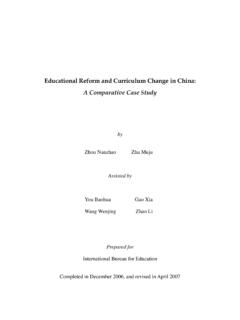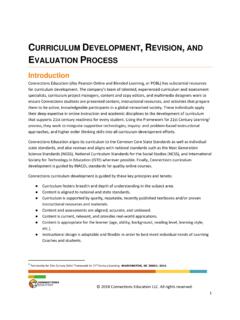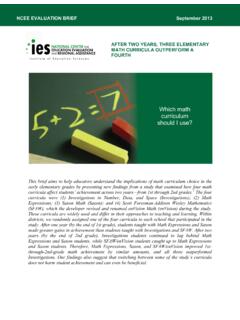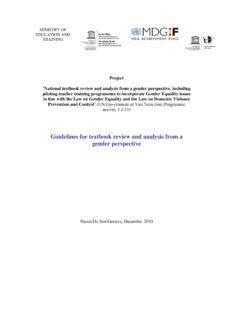Transcription of History of Social Studies - ed
1 ON THE ALLEGED DEMISE OF Social Studies : THE ECLECTIC curriculum IN TIMES OF STANDARDIZATION A HISTORICAL SKETCH DAVID WARREN SAXE Social Studies is a survivor, enduring as a mainstay of the American curriculum for nearly 100 years. Its longevity is not a tribute to its curricular power nor can we credit a cadre of finely trained professionals for maintaining its influence. Rather, Social Studies remarkable survival is due to the near-universal acceptance of the idea that this chameleon-like entity allows practitioners to cast and recast its form and substance into whatever shape desired. This flexible-all-inclusive-eclectic nature of Social Studies stems from its first official definition issued in 1916. The Social Studies are understood to be those whose subject matter relate to the organization and development of human society, and to man as a member of Social At the turn of the century, in looking toward the future, all that America had become ( , its inventive genius, its unlimited resources harnessed, its great commercial and industrial power, its magnificent cities and its teeming humanity) rested on the ability of man as a member of Social groups to negotiate the issues, problems, and concerns that such modernity created.
2 In the face of these realities, the curricular needs of American society could only be met by attending to man s contemporary Social aspects, not his past. Here, the engine of American education would be enlisted to serve the people. As children were freed from their bolted down nineteenth century seats, Social Studies , a new flexible and unregimented twentieth century curricular program, was invented to meet the demands of this progressive new society. In practice, Social Studies content would be drawn from the whole of human experience and was purposely not tied to any specific content area. And, what was the purpose of studying this content? According to the seminal 1916 Committee on Social Studies , which introduced the field to American educators: The Social Studies differ from other Studies by reason of their Social content rather than in Social aim; for the keynote of modern education is Social efficiency, and instruction in all subjects should contribute to this [F]rom the nature of their content, the Social Studies afford peculiar opportunities for the training of the individual as a member of [S]ociety may be interpreted to include the human race.
3 The Social Studies should cultivate a sense of membership in the world community, with all the sympathies and sense of justice that this involves as among the different divisions of human Throughout the twentieth century, educators applied this loose concept of Social Studies as the basis for creating experimental curricula. Often in strong opposition, another cast of Social Studies figures drew inspiration and content from the older traditional History curriculum introduced at the end of the nineteenth century. Like any other educational innovation, Social Studies was not created in a vacuum. Its invention was as much a reaction to prevailing curricula as it was an innovation. For citizenship education purposes, what existed in most high schools prior to Social Studies was a History -centered program introduced by the Committee of Seven, in 1899, calling for formal Studies in ancient, medieval, modern and American histories as gateways toward effective Issued under the authority of the American Historical Association, the four-block program for high schools was designed to furnish students as citizens of a free state with the mental equipment to comprehend the political and Social problems that will confront him in everyday life.
4 4 The greatest aim of education, the Committee of Seven claimed, was to impress upon the learner a sense of duty and responsibility, and an acquaintance with his human obligations. 5 The Committee was adamant that the curriculum include: four years of work, beginning with ancient History and ending with American recommend that they be studied in the order in which they are set down, which in large measure accords with the natural order of events, and shows the sequence of historical No one of these fields can be omitted without leaving serious lacunae in the pupil s knowledge of the Committee of Seven report did not contain the amount of specific content as found in modern state History standards from such states as California, Massachusetts, or Virginia, or even the recently condemned national Standards for History , publishers nonetheless supplied textbooks well-stocked with dates, events, personalities and issues all chronologically arranged and largely standardized throughout the industry.
5 In 1935, when the textbook was the curriculum , Rolla Tryon wrote that the fact of the matter is that a textbook intended for high school use in History published between 1900-1915 had hard sledding if it failed to claim that it conformed to the report of the Committee of Seven. 7 Tryon also noted that for at least two decades after [the Committee of Seven report appeared], high school courses in History in the United States were almost 100 percent dictated by it. Even today [1935] more than a generation after the publication of the report, its influence is dominating in probably one-third of the high schools of the country. 8 Despite the virtual lock on schools, the History -centered curriculum was attacked by Social Studies insurgents for more than a decade before the 1916 Committee on Social Studies completed its work.
6 In reaction to a growing number of critiques that held the History curriculum as unsuited to the pressures and realities of modern life, historian John Bach McMaster responded confidently in 1905, that in the process of Americanizing the foreigner [and all other children] we must fill their minds with the facts of American History which they may not understand, but which they must take as so much medicine. 9In contrast, Social worker Jane Addams, well acquainted with settling recent immigrants in Chicago, argued in 1907 that the usual effort to found a new patriotism upon American History is often an absurd undertaking. 10 Between these two positions, the hard-edge of Americanization applied to children and the softer progressive position that worked from the needs and interests of children, the Social Studies movement emerged.
7 Although Social Studies theorists had argued persuasively enough to gain the support of the Bureau of Education as well as the sponsoring national Education Association in advancing Social Studies , the History curriculum did not disappear. In fact, as Tryon noted, the Committee of Seven s History program survived intact in many schools through World War II. Moreover, this author can attest that traces of the four-block scheme continued into the 1960s as his high school offered the Committee of Seven s four-block program. Despite History s resiliency, the critics point that History s contribution to the modern curriculum could only be useful if it cast light on contemporary problems proved potent, if not commanding. Although the stewards of History sought to maintain the traditional History curriculum to train the intellect, Social Studies practitioners relentlessly pressed their demands that every content area must pass the test of Social utility as a subject area that contributed to understanding and resolving contemporary Social problems.
8 Given the flexibility of school systems to determine their own methods and programs for citizenship education, in time, some came to see Social Studies as History , geography, civics and government, economics, and other content areas loosely constructed around the teaching of citizenship. Others saw Social Studies as a unique field in its own right where young citizens learned the process-skills and methodologies necessary for citizenship. Until the 1990s, when the standards movement took hold in most states, it did not matter if a local school district followed a History -center approach to citizenship education or if it adopted any one of dozens of Social Studies approaches to citizenship. Thus, before the state standards movement, these two or three traditions of the field to be content-centered or process-centered or some combination of both fit neatly under the big tent of Social Studies .
9 Programs and curricula may have differed from school to school, but all were identified by the same name: Social Studies . With the push for greater specificity and accountability in the standards-base movement instituted at the end of the twentieth century, those who wished to maintain Social Studies as a term of eclectic convenience were confronted with public polices and state regulations that demanded a specific curriculum with defined content and skills to be taught, learned, and assessed for all schools within state authority. One hundred years ago, educators and policymakers had instituted a prescriptive program in History education. Taking up the educational philosophy of John Dewey, some eighty years ago, Social Studies advocates instituted a loosely constructed citizenship program that marginalized History .
10 In turn, by the late twentieth century many states adopted a standards-base model that reinstituted prescriptive curricula. We had traveled full circle. While some state standards reflected a renewed interest in History -centered (and other discrete subject matters) and dropped Social Studies by title, many others simply converted their curricula into content-centered standards with Social Studies remaining as the masthead. Still others retained the eclectic Social Studies . The question of whether or not History -centered models will return in force or the eclectic Social Studies will recover ground lost in the standards-based movement remains to be answered. However, one thing is clear throughout the past century: It does not matter if History -centered models were couched as Social Studies or if Social Studies programs presently appear subdued by History -centered initiatives, neither History nor Social Studies has fully disappeared in schools.


















